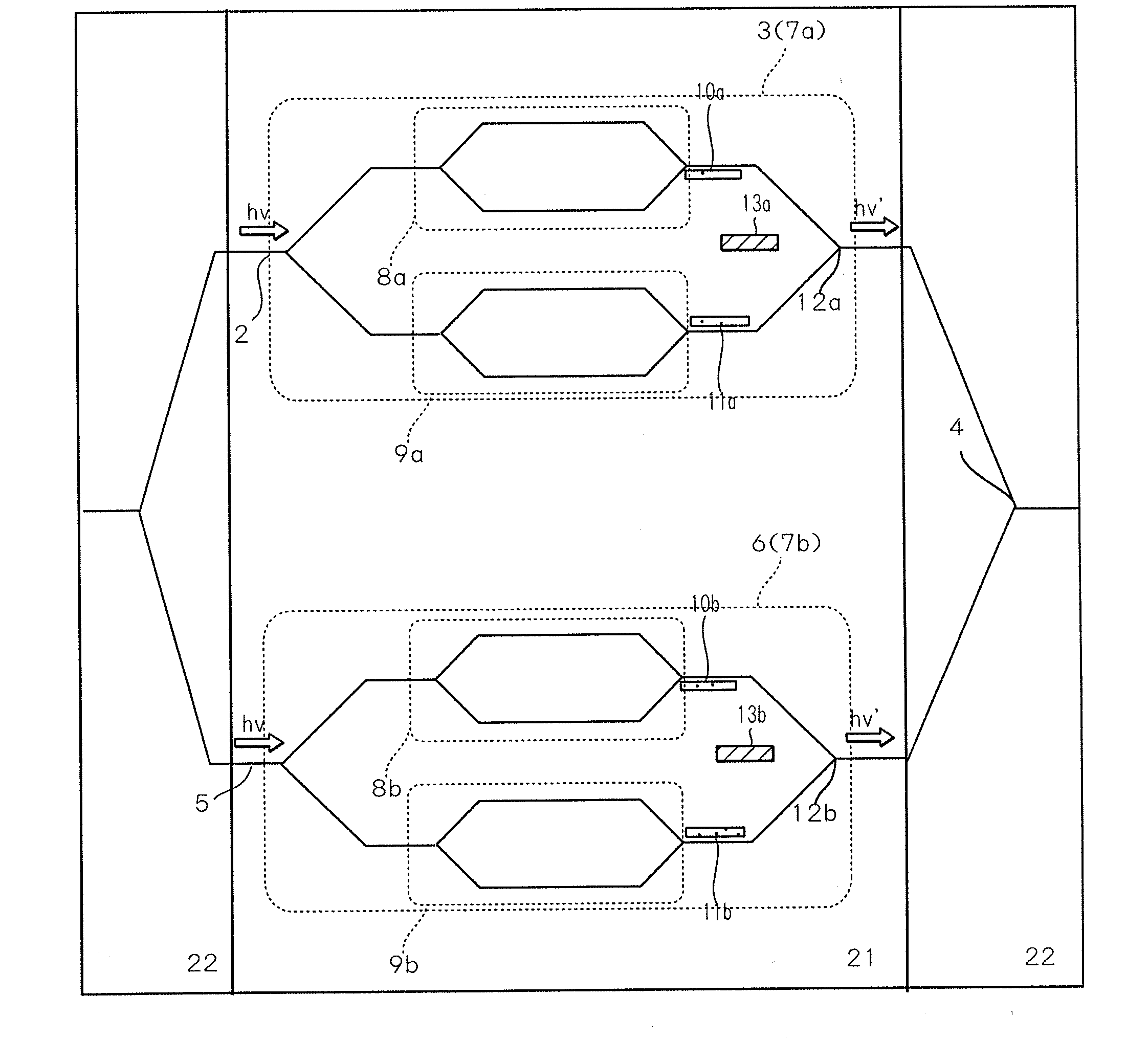Quadrature amplitude modulation signal generating device
a signal generator and quadratic amplitude technology, applied in phase-modulated carrier systems, frequency-modulated carrier systems, digital transmission, etc., can solve problems such as difficult to handle multi-level electrical signals
- Summary
- Abstract
- Description
- Claims
- Application Information
AI Technical Summary
Benefits of technology
Problems solved by technology
Method used
Image
Examples
first example
16 QAM Mapping Using Two QPMZMs
[0093]FIG. 4 shows a diagram illustrating the principle of a 16 QAM modulator of the present invention. In this example, two kinds of QPSK signals having different amplitudes (intensity) are superimposed on each other in order to obtain 16 QAM signals. The intensity difference between the two QPSK signals was set to be 6 dB. The QPSK signal having larger amplitude (which is shown by QPSK2 in FIG. 4) determines the area in which a quadrant is mapped. Meanwhile, the QPSK signal having smaller amplitude (which is shown by QPSK1 in FIG. 4) fixes the position of each quadrant. By combining two QPSK signals with each other, 16 equally-spaced symbols can be mapped in a phase diagram. This 16 QAM mapping can be obtained using binary data without using multilevel electrical signals.
second example
QPMZM for 16 QAM
[0094]As shown in FIG. 5, in the present example, using the optically connected LiNbO3 waveguides and silicon-based PLC (planar lightwave circuit), a modulator comprising a QPMZM (quadruplex parallel MZMs) for 16 QAM modulation was manufactured. This QPMZM was manufactured by arranging four MZMs (MZM-I, MAM-Q, MZM-i, and MZM-q) in parallel. In other words, this QPMZM was provided with two DPMZMs (dual parallel MZMs). Each MZM was provided with traveling-wave-type electrodes (RFa1, RFb1, RFa2, and RFb2). As shown in FIG. 5, the QPMZM was further provided with six bias electrodes for controlling the phase offset between the MZMs. The input and output of the two DPMZMs were coupled to PLC-based optical couplers at their ends.
[0095]The electro-optic frequency response in each electrode is shown in FIG. 6. In FIG. 6, the modulation electrodes of the bandwidths of 3 dB and 6 dB were approximately 10 GHz and 25 GHz. In other words, it was found that this modulator can be us...
third example
Modulator for 50-Gb / s 16 QAM Modulation
[0096]FIG. 7 is a schematic diagram showing the configuration of the device used in the present example. Within a transmitter, the continuous light from an external cavity semiconductor laser diode (LD) was subjected to 16 QAM modulations by a QPMZM. Each arm of a modulator was push-pull-driven using the PRBS (pseudo random bit sequence) of 12.5 Gb / s binary NRZ (non-return-to-zero) with a data length of 29−1 generated by a commercial 4-channel pulse pattern generator (PPG). A pair of MZMs (MZM-I and MZM-Q) was driven within a range between −π to π in order to obtain large-amplitude QPSK signals. The remaining pair of MZMs was driven within a range of −π / 2 to π / 2 in order to obtain small-amplitude QPSK signals.
[0097]Within a receiver, a signal was demodulated using a digital homodyne wave detector. The digital homodyne wave detector combined a signal with local oscillator (LO) light using an optical hybrid coupler. For simplicity, the LO light w...
PUM
 Login to View More
Login to View More Abstract
Description
Claims
Application Information
 Login to View More
Login to View More - R&D
- Intellectual Property
- Life Sciences
- Materials
- Tech Scout
- Unparalleled Data Quality
- Higher Quality Content
- 60% Fewer Hallucinations
Browse by: Latest US Patents, China's latest patents, Technical Efficacy Thesaurus, Application Domain, Technology Topic, Popular Technical Reports.
© 2025 PatSnap. All rights reserved.Legal|Privacy policy|Modern Slavery Act Transparency Statement|Sitemap|About US| Contact US: help@patsnap.com



